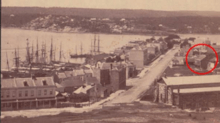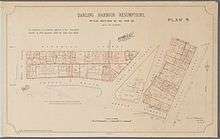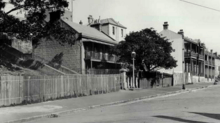Darling House, Millers Point
| Darling House | |
|---|---|
 | |
| General information | |
| Type | Heritage listed house |
| Architectural style | Georgian |
| Location | Dawes Point |
| Town or city | Sydney |
| Country | Australia |
| Coordinates | 33°51′27″S 151°12′24″E / 33.8575°S 151.2067°ECoordinates: 33°51′27″S 151°12′24″E / 33.8575°S 151.2067°E |
| Groundbreaking | 1842 |
Darling House is an Australian Georgian-style Old Colonial sandstone house located in the suburb of Dawes Point, Sydney (also known as Millers Point). Construction of the house began in 1842 and was completed in 1844 under the ownership of Joseph Farris.[1] The name of the house, which originated from the local community in the 1800s, is derived from the original land grant by Governor Darling.[2] Darling House holds particular historical, social and architectural significance due to its influence on the history and early social development of Millers Point and early colonial Australia[3] and as a representative example of Georgian style architecture in neo-colonial Australia.[4] Darling House is distinctive as one of only a few remaining free standing dwellings in the area and rarer still for its generous curtilage in the form of landscaped gardens.[5]
Heritage significance
Darling House is registered as an item of heritage significance on both the New South Wales state heritage register[6] and the Sydney Local Environment Plan.[7] Being located within, and described as the “crown jewel”[8] of, Dawes Point, Darling House has also been included in the various heritage listings that apply to the Millers Point/Dawes Point precinct as a whole including the Millers Point and Dawes Point Conservation Area,[9] Millers Point & Dawes Point Village Precinct[10] and the Millers Point Conservation Area.[11]
Local history
Originally known by the Aboriginal names of Tar-ra and Tullagalla, Dawes Point was later renamed after Lieutenant William Dawes (1762 - 1836), astronomer with the First Fleet. Before white settlement the area was home to the Cadigal (also spelled Gadigal) aboriginal tribe.[12] Dawes Point holds historical significance as it was the site of the first guns mounted in Sydney in 1788, as well as the Dawes Point Battery, Sydney’s first cemetery and the site of Sydney’s first port facilities. The area is also commonly referred to as Millers Point or The Rocks.
Construction of Darling House
Darling House was built between 1842 and 1844 by Joseph Farris, during a period of depression in Sydney.[13] It was built in response to the population growth in the local area, with the intent to provide residential accommodation.[14] The site on which the house was built comprised two allotments, the northern allotment was granted to Joseph Farris and the southern allotment was to granted Michael Gannon, a local builder. Soon after the allotments were granted Gannon admitted that, at the time the grant was made, the southern allotment was actually the property of Farris and in 1842 Gannon formally conveyed the allotment to Farris for the nominal sum of five shillings.[15]

Prior to the construction of Darling House the site had been used as a sandstone quarry and it is from this quarry that the hand carved sandstone bricks from which the house is built are likely to have been quarried.[16]
Upon construction, the interior of the house was divided by a large corridor. On the ground floor to the left of the corridor there was a dining/living room with two bedrooms on the right. On the upper floor there were four bedrooms on either side of the corridor. A stone kitchen and breakfast room were connected to the rear of the house, a bathroom to the right of the backdoor and timber laundry against the rock face.[17] During the 1860s the ground and first floor Victorian verandas were added to the house, with the first floor windows being converted into French doors. These modifications are classic representative examples of the development of Australian architecture away from the traditional English styles in response to local environmental factors. English bald faced buildings offered little protection against the sun while the French doors and veranda allowed for greater air circulation through the house alleviated the effects of the heat during the summer months.[18] Such architectural features are illustrative of the way in which Australian architectural styles were forced to differ from the traditional English styles to accommodate for the vastly different Australian climate.
Joseph Farris
Joseph Henry Farris was born in England in 1807, to Joseph Farris and Hannah Longhurst. In 1827 Farris’ father died, leaving him an inheritance which he used to book passage for himself and his wife to Australia. As a free settler, Farris quickly established himself as a prolific local businessman plying his trade as a boat builder, publican and Sargent in the water police. As a prominent individual in Sydney at the time, Farris’ name was inscribed upon the visiting list at Government House.[13] An avid boat builder and regatta competitor, in 1832 Farris built the first boat ever manufactured in Australia, which he subsequently raffled off for a total of 30 pounds.[19]
On Friday the first boat built in this Colony, on the plan of a London wherry, was launched from the yard of Mr. Farris, boat builder, in Windmill Street. She is 25 feet 8 inches keel, and 4 feet 4 inches beam. She was built to contend with Major Lockyer's wherry, received per Clyde. The match will come off shortly.— Sydney Morning Herald, 22 November 1832
Farris obtained prominence around Sydney as a publican, holding licences for the Whalers Arms Hotel located on the corner of Windmill Street and Fort Street,[20] the Young Princess Hotel (now the Hero of Waterloo)[21] and the Shakespeare Hotel.[22]
Ownership by the Farris’
Given that Farris never resided at Darling House, insteading leasing the house out to various middle-class residents up until his death, and owned three other commercial residences on Fort Street it appears most likely that Farris built the house solely as a commercial venture.[13] The first public record of the house is an advertisement dated 24 October 1842, which read:[23]
That first-rate stone dwelling House, late in the occupancy of Mr. Arnold, situated in Fort-street, containing eight Rooms, with detached kitchen, coal and wine cellar Rent very moderate. Apply to Mr. Joseph Faris, Young Princess Inn, Fort-Street. N.B. A purchaser will be treated with.— Sydney Morning Herald, 24 October 1842
The house originally suffered from the constant discharge of water closets from the houses facing Prince’s Street. The stench was so bad that the occupiers were compelled to close all the doors and windows at the back of the house to keep out the horrid smells. Upon the death of Joseph Farris, circa. 1859,[24] his widow Elizabeth Farris resided in the house between until 1867. During this time Mrs Farris rented out a number of the rooms and kept an aviary and goats on the property.
Outbreak of plague
Darling House was resumed by the Sydney Harbour Trust in response to the outbreak of the bubonic plague in Sydney in 1900.[25] Following the first diagnosis of the plague in Sydney 1900, that of Arthur Paine a carter who worked in the rocks, the New South Wales Government and Sydney Council began a quarantine and cleansing operation in the Rocks, Millers Point (including present day Dawes Point) and Darling Harbour.[26]

Despite the plague epidemic being over, the Sydney Harbour Trust resumed almost all of the properties in the Rocks, Millers Point and Darling Harbour between 1900 and 1902 in order to clean up the area and implement quarantine measures.
On 29 December 1900 the Sydney Harbour Trust issued notice in the Government Gazette of the resumption of Darling House, which occurred in 1901 under the Darling Harbour Wharves Resumption Act 1900. Darling House was fortunate to survive this period as many of the houses in the area were deemed unhygienic and demolished, with the backyards being covered in concrete or asphalt.[17]
20th Century
Upon resumption by the Sydney Harbour Trust, Darling House was almost immediately converted into a boarding house, leased by the State Government of New South Wales.[27] After 1901 Darling House and the vacant land on the southern allotment are clearly distinguished as separate entities in the rates assessment books. This makes the distinction between the use of Darling House, as a boarding house and residential accommodation, and the use of the southern allotment for commercial purposes, particularly clear. In 1948-49 Darling House was converted into a warehouse, resulting in the demolition of most of the internal walls and outbuildings on the property to allow vehicle access to the back of the house. From that point on the house was leased to a variety of commercial companies, the last reordered of which was Lep Transport who installed a petrol tank and bowser onto the property.[28]
During this time residents of the local area have recalled the southern allotment being used for a variety of purposes including an outdoor cinema and a plasterer’s workshop.[29] The rates assessment books during this time also record the site as being leased to Chas Rasmussen & Co, makers/repairers of casks and barrels, and as a cooperage, store and laundry. After Lep Transport vacated the facility, the year of which is unknown, the property remained vacant and fell into a state of disrepair.[28]
Caraher's Stairs

In 1857 Caraher’s Stair was constructed, flanking the northern wall of Darling House. The stairs were constructed to provide local residents access up to Princes Street (now the site of the Sydney Harbour Bridge) and were named after Owen Joseph Caraher, a local soap merchant. The stairs were a prominent thoroughfare, providing access between Millers Point and central Sydney. In 1933 the stairs were demolished as part of the construction of the Sydney Harbour Bridge.[30]
Conversion into an aged care facility
In 1994 Darling House underwent extensive renovations under the design of heritage architect Howard Tanner, including the construction of a new dwelling on the southern allotment, in order to convert the house into an aged care facility. The conversion into an aged care facility was a community initiative of the Resident Action Group in Partnership with the Rocks Cottage Type Nursing Home Committee. It was a community funded and supported organisation from the time of its opening on 4 October 1994 until 2015.[31]
In 2014 the State Government of New South Wales made the decision to sell 293 Government owned houses in Millers Point and Dawes Point to private purchasers, which it did throughout 2014, 2015 and 2016.[32] In 2015 the State Government of New South Wales made the decision to raise the rent on Darling House from five dollars per month to a market rate, which led to the sale of the property.[33]
Current owner
In 2015 Darling House was purchased by Dr. Shane Moran of the Provectus Care Group in order to retain Darling House as an aged care facility.
List of occupants
Figures 1 and 2 below depict the list of known occupants of Darling House as inscribed in the Sydney City Council Rates Assessment Books and Sands Directory respectively.
Sydney City Council Rates Assessment Books
| Date | Person rated | Owner/landlord |
|---|---|---|
| 1845 | James Hill | Mrs Farris |
| 1848 | H. James | Farris |
| 1851-2 | Ann Price | Joseph Farris |
| 1855-6 | J. B. Ward | Joseph Farris |
| 1861 | Empty | Joseph Farris |
| 1863 | Elizabeth Farris | Elizabeth Farris |
| 1867 | Mrs Farris | Mrs Farris |
| 1871 | Leopold F. Sachs | -- Ferris |
| 1877 | Rosa Strange | Mr Ferris |
| 1880 | Mrs R Strange | Mr Ferris |
| 1882 | Rose Strange | Mrs Ferris |
| 1891 | Mrs Strange | ? |
| 1906 | John Macki | Ann Macpherson |
| 1910 | John R Mackie | NSW Gov't (Rocks Resumptions) |
| 1915 | John Russell | NSW Gov't |
| 1918 | John Mussen | NSW Gov't |
| Charles G. Rasmussen & Co | NSW Gov't |
Figure 1.[34]
Sands directory
| Date | Occupant | Occupation |
|---|---|---|
| 1858-9 | Ward, T.B. | |
| 1861 | Brown, William | Mariner |
| 1863 | Sachs, Leopold Ferdinand | Surgeon |
| 1864 | Sachs, Leopold F. | |
| 1865-6 | Sachs, Leopold Ferdinand, Dr. | |
| 1867-70 | Sachs, Leopold Ferdinand | M.D. |
| 1871 | Sachs, L.F. | M.D. |
| 1873 | Sachs, Leopold | M.D. |
| 1875 | Osbourne, George | |
| 1876 | Sachs, Leopold F. | M.D. |
| 1877-87 | Strange, Mrs Rosa | |
| 1888-1890 | George, Mrs | Boarding house |
| 1891-1897 | No reference to occupants | |
| 1901-1908 | Mackie John R | |
| 1909-1910 | Macki, Mrs Nellie | |
| 1911 | Gibbons, Mrs Kate | Lodging House |
| 1912-20 | Mussell John | Boarding House |
| 1921 | Mackenzie J.H. & Co. | Manufactures and importers |
| 1921 | Rassmussen Chas. C. & Co. | Coopers (vacant lot) |
| 1922 | Mackenzie J.H. & Co. | Manufacturing chemists |
| 1923 | Olden, Mrs. Marion | Example |
| Rassmussen, Wyatt & Bortchie Ltd | Coopers |
Figure 2.[34]
Notable residents
Doctor Leopold Sachs
Doctor Leopold Sachs resided in Darling House from 1861 to 1876. Doctor Sachs was a prominent Sydney surgeon and homeopathic doctor, [35] renowned for giving free medical advice to the poor. [36]
Rosa Strange
Mrs Rosa Strange was the wife of prominent naturalist Frederick Strange, who accompanied Charles Sturt on his 1844 expedition to Central Australia. She resided in Darling House through the late 1870s and 1880s and ran a school in the local area.[35]
Rosaleen Norton
Rosaleen Norton, also known as the Witch of Kings Cross, lived in Darling House at the time that it was a boarding house in the early 1900s. She received prominence due to her satanic drawings that were often published in local tabloid newspapers.[35]
References
- ↑ Urbis, Construction Management Plan: Darling House, 8 – 12 Trinity Avenue, Dawes Point, November 2015, p. 17.
- ↑ Urbis, Construction Management Plan: Darling House, 8 – 12 Trinity Avenue, Dawes Point, November 2015, p. 18.
- ↑ Urbis, Construction Management Plan: Darling House, 8 – 12 Trinity Avenue, Dawes Point, November 2015, p. 81.
- ↑ Urbis, Construction Management Plan: Darling House, 8 – 12 Trinity Avenue, Dawes Point, November 2015, p. 83.
- ↑ Urbis, Construction Management Plan: Darling House, 8 – 12 Trinity Avenue, Dawes Point, November 2015, p. 80.
- ↑ ‘Building’, 8, 10, 12 Trinity Avenue, Millers Point, SHR Listing No. 00842
- ↑ ‘House “Darling House (8-12 Trinity Avenue) including interior’, 24-42 Lower Fort Street, LEP Inventory No. I549.
- ↑ http://www.canberratimes.com.au/video/video-property/video-domain/the-crown-jewel-of-millers-point-20160122-49eih.html
- ↑ City of Sydney LEP 2012 (CA35).
- ↑ New South Wales State Heritage Register (Listing No. 01682).
- ↑ New South Wales State Heritage Register (Listing No. 00884).
- ↑ https://www.rbgsyd.nsw.gov.au/about-us/history-and-facts/indigenous-heritage
- 1 2 3 Urbis, Construction Management Plan: Darling House, 8 – 12 Trinity Avenue, Dawes Point, November 2015, p. 19.
- ↑ Urbis, Construction Management Plan: Darling House, 8 – 12 Trinity Avenue, Dawes Point, November 2015, p. 79.
- ↑ Urbis, Construction Management Plan: Darling House, 8 – 12 Trinity Avenue, Dawes Point, November 2015, p. 18-19
- ↑ University of Sydney, Excavation Report: Darling House, Millers Point, Vol. 1 for Department of House, p. 9.
- 1 2 University of Sydney, Excavation Report: Darling House, Millers Point, Vol. 1 for Department of House, p. 6.
- ↑ Urbis, Construction Management Plan: Darling House, 8 – 12 Trinity Avenue, Dawes Point, November 2015, p. 21.
- ↑ Sydney Herald, 22 November 1832, available at: http://trove.nla.gov.au/newspaper/article/12845784?searchTerm=farris&searchLimits=sortby=dateAsc
- ↑ The Australian, 5 August 1831, available at: http://trove.nla.gov.au/newspaper/article/36866118?searchTerm=farris&searchLimits=sortby=dateAsc
- ↑ Sydney Herald, 1 May 1841, available at: http://trove.nla.gov.au/newspaper/article/12868924?searchTerm=faris&searchLimits=sortby=dateAsc
- ↑ Bell’s Life in Sydney and Sporting Reviewer, 30 October 1847, available at: http://trove.nla.gov.au/newspaper/article/59764018?searchTerm=faris&searchLimits=sortby=dateAsc
- ↑ http://trove.nla.gov.au/newspaper/article/12426384
- ↑ http://trove.nla.gov.au/newspaper/article/60406481?searchTerm=Faris&searchLimits=exactPhrase|||anyWords|||notWords|||requestHandler|||dateFrom=1859-07-14|||dateTo=1859-07-16|||sortby=dateAsc
- ↑ https://sydney.edu.au/medicine/museum/mwmuseum/index.php/Bubonic_Plague_comes_to_Sydney_in_1900
- ↑ http://gallery.records.nsw.gov.au/index.php/galleries/through-the-lens-darling-harbour/
- ↑ Urbis, Construction Management Plan: Darling House, 8 – 12 Trinity Avenue, Dawes Point, November 2015, p. 26.
- 1 2 Urbis, Construction Management Plan: Darling House, 8 – 12 Trinity Avenue, Dawes Point, November 2015, p. 27.
- ↑ University of Sydney, Excavation Report: Darling House, Millers Point, Vol. 2 for Department of House, s.8.
- ↑ Urbis, Construction Management Plan: Darling House, 8 – 12 Trinity Avenue, Dawes Point, November 2015, p. 29-31.
- ↑ Plaque located on the property.
- ↑ http://www.theaustralian.com.au/business/property/millers-point-sale-could-bank-470m-for-building-new-homes/news-story/6b2b73dd2b01c0fab2b736a43500f3b1
- ↑ http://www.domain.com.au/news/the-crown-jewel-of-millers-point-government-houses-to-be-sold-off-20160122-gmb919/
- 1 2 University of Sydney, Excavation Report: Darling House, Millers Point, Vol. 1 for Department of House, p. 8.
- 1 2 3 University of Sydney, Excavation Report: Darling House, Millers Point, Vol. 1 for Department of House, p. 50.
- ↑ http://trove.nla.gov.au/newspaper/article/12998926?searchTerm=%22dr%20sachs%22&searchLimits=l-advstate=New+South+Wales|||dateTo=1910-01-01|||dateFrom=1855-01-01|||sortby=dateAsc